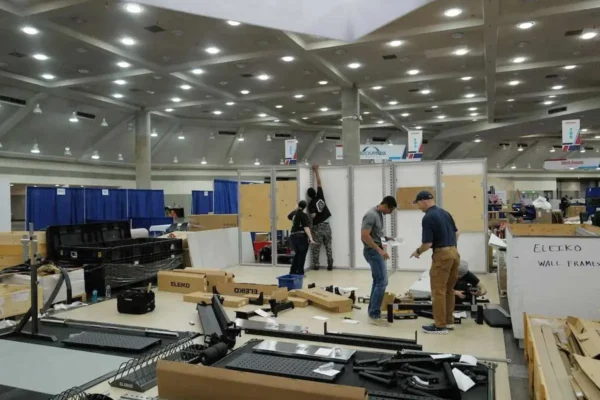by Bob McGlincy
Pandemics have occurred throughout history, and have killed more than 100 million people in the last 200 years. However, their impact on tradeshows, prior to 2020, seems to have been minimal.
| Year | Name | Deaths,
worldwide |
Deaths,
U. S. |
Population
U.S./Year |
| 1817-1824 | 1st Cholera | 2,000,000+ | 0 | 9.6 million 1820 |
| 1826-1834 | 2nd Cholera | 400,000 | 40,000 | 12.8 million 1830 |
| 1852-1860 | 3rd Cholera | 1,000,000 | 110,000 | 31.4 million 1860 |
| 1863-1875 | 4th Cholera | 600,000 | 50,000 | 38.5 million 1870 |
| 1881-1896 | 5th Cholera | 900,000 | 50,000 | 62.9 million 1890 |
| 1889-1890 | Russian Flu | 1,000,000 | 13,000 | 62.9 million 1890 |
| 1855-1905 | 3rd Plague | 15,000,000 | 119 (in 1904) | 76.1 million 1900 |
| 1910-1911 | 6th cholera | 800,000 | 11 | 92.4 million 1910 |
| 1918-1919 | Spanish Flu | 50,000,000 | 675,000 | 103.2 million 1918 |
| 1956-58 | Asian Flu | 1,100,000 | 116,000 | 172.0 million 1957 |
| 1968 | Hong Kong Flu | 1,000,000 | 100,000 | 200.7 million 1968 |
| 1981-2018 | AIDS | 36,000,000 | 700,000 | 282.2 million 2000 |
| 2009 | Swine Flu | 575,400 | 12,469 | 306.8 million 2009 |
| 2020-2021 | COVID (6/13/21) | 3,810,000 | 600,000 | 331.4 million 2021 |
Disease and epidemics spread across the globe during the 19th century. Typhus, smallpox, yellow fever and scarlet fever—all ravaged nations indiscriminately. It’s estimated that smallpox killed more than 400,000 people in Europe alone in the 1800s. The single biggest worldwide killer was cholera: there were six separate pandemics between 1816 and 1911, killing more than five million people (although one source estimates 15 million people died in India alone during the first three cholera pandemics). The third plague killed more people, but the disease was limited to China and India.
During the 1800s, there were more than 300 major exhibitions, expositions, or “world’s fairs.” So, what was the impact on shows during this period? Despite some vocal concerns, there appears to have been little or no impact whatsoever. There were no cancellations.
- The American Institute Fair opened in New York City in 1829. Considered by some to be “America’s First World’s Fair,” it continued every year until 1897. The first cholera wave to hit New York City was in 1832, and it caused a third of the city’s population to flee … but the show still attracted 30,000 attendees that year.
- The Eighth French Industrial Exposition was cancelled in 1832 due to the Paris riots. It was rescheduled for 1834. In 1833, cholera killed 2.5 percent of Paris’ population. The show opened as planned in 1834, and attracted a record 2,447 exhibitors (attendance was free; total unknown).
- Cholera spread through London in 1848 and Ireland in 1849 during the planning stages of The Great Exhibition. The show opened as scheduled in 1851 and attracted more than 6 million paid visitors.
- Scarlet fever and cholera hit California, staring in 1849 and lasting through 1855. The annual California State Fair first opened in 1851.
- Cholera hit New York City a second time in 1854. The “Exhibition of the Industry oaf All Nations” attracted 750,000 visitors that year.
- The “First General German Industry Exhibition” opened in Munich on July 15, 1854 in the middle of a devastating cholera outbreak. The show attracted more than 90,000 visitors on opening day.
- The Paris Expo of 1855 attracted more than 5 million people despite the re-occurrence of cholera in the city that year.
- Smallpox and cholera hit Vienna in the early 1870s. The Expo of 1873 attracted more than 7 million people.
- Cholera came to America in 1873, along with financial Panic of ‘73; each lasted for several years. The Philadelphia Centennial Exposition opened on schedule in May 1876, and attracted more than 10 million visitors.
- Cholera and the flu invaded all of Europe in 1889 and 1890. The Paris Expo attracted more than 27 million people in 1890.
During the second half of the 19th century, 42 shows averaged 5.6 million attendees per show. And this was during a time of millions of pandemic deaths.
In the 20th century, different versions of the flu replaced cholera as the dominant killer. (Ebola and Zika are not listed in the table above. Although potentially serious, their epidemics were controlled: for example, Ebola had 11,325 deaths between 2014-2016). The deadliest of the flus was the 1918 influenza pandemic, also known as the “Spanish Flu.” It was caused by the H1N1 influenza A virus, and lasted from February 1918-April 1920; it infected about a third of the world’s population and killed an estimated 50 million people (estimates from different sources range from 17 to 100 million, although 50 million is the generally accepted number). So, what was the impact on events in the U.S. in 1919?
- The World Series between Chicago and Cincinnati was played, as scheduled that year, with an average attendance of 29,537 people. The flu did not affect the attendance, but may have affected the outcome: pitcher Red Faber came down with the flu and was left off the Series roster. Had Farber been available, Eddie Cicotte, one of the “Black Sox” eight, would not have pitched, and lost, as many games.
- Auto shows in New York, Chicago and Detroit continued as scheduled.
- It is likely that NAMM, Toy Fair, Promotional Products and IAAPA had their shows that year. They had shows both prior to and after 1919.
- The National Restaurant Show’s first year was 1919.
While based on anecdotal evidence, it appears that pandemics had minimal impact on expositions between 1820 and 1920. A look at the next 100 years will be reviewed in Part Two.
![]() Bob McGlincy is director, business management at Willwork Global Event Services. Willwork creates engaging, energized, and exceptional event experiences. He can be contacted at Bob.McGlincy@willwork.com
Bob McGlincy is director, business management at Willwork Global Event Services. Willwork creates engaging, energized, and exceptional event experiences. He can be contacted at Bob.McGlincy@willwork.com






























